Leadership Approach Report: Personal Skills, Behavior, and Frameworks
VerifiedAdded on 2022/08/16
|8
|2508
|16
Report
AI Summary
This report delves into a student's personal approach to leadership, focusing on the influence of motivation, communication, and collaboration. It explores various leadership theories, including situational, Great Man, trait, transformational, and laissez-faire approaches, highlighting how these theories explain the student's behaviors and skills. The report also examines leadership frameworks, such as path-goal and coach styles, and how they have been applied in practical organizational settings to address challenges like employee turnover and organizational expansion. The student reflects on their experiences as a manager, detailing how they adapted their leadership style to suit different situations and employee needs. The report concludes with recommendations for effective leadership practices and emphasizes the importance of self-awareness, participative approaches, and the strategic use of appropriate leadership frameworks to enhance organizational productivity and employee motivation.

RUNNING HEAD: LEADERSHIP APPROACH 0
Leadership Approach
Student’s Details-
Leadership Approach
Student’s Details-
Paraphrase This Document
Need a fresh take? Get an instant paraphrase of this document with our AI Paraphraser
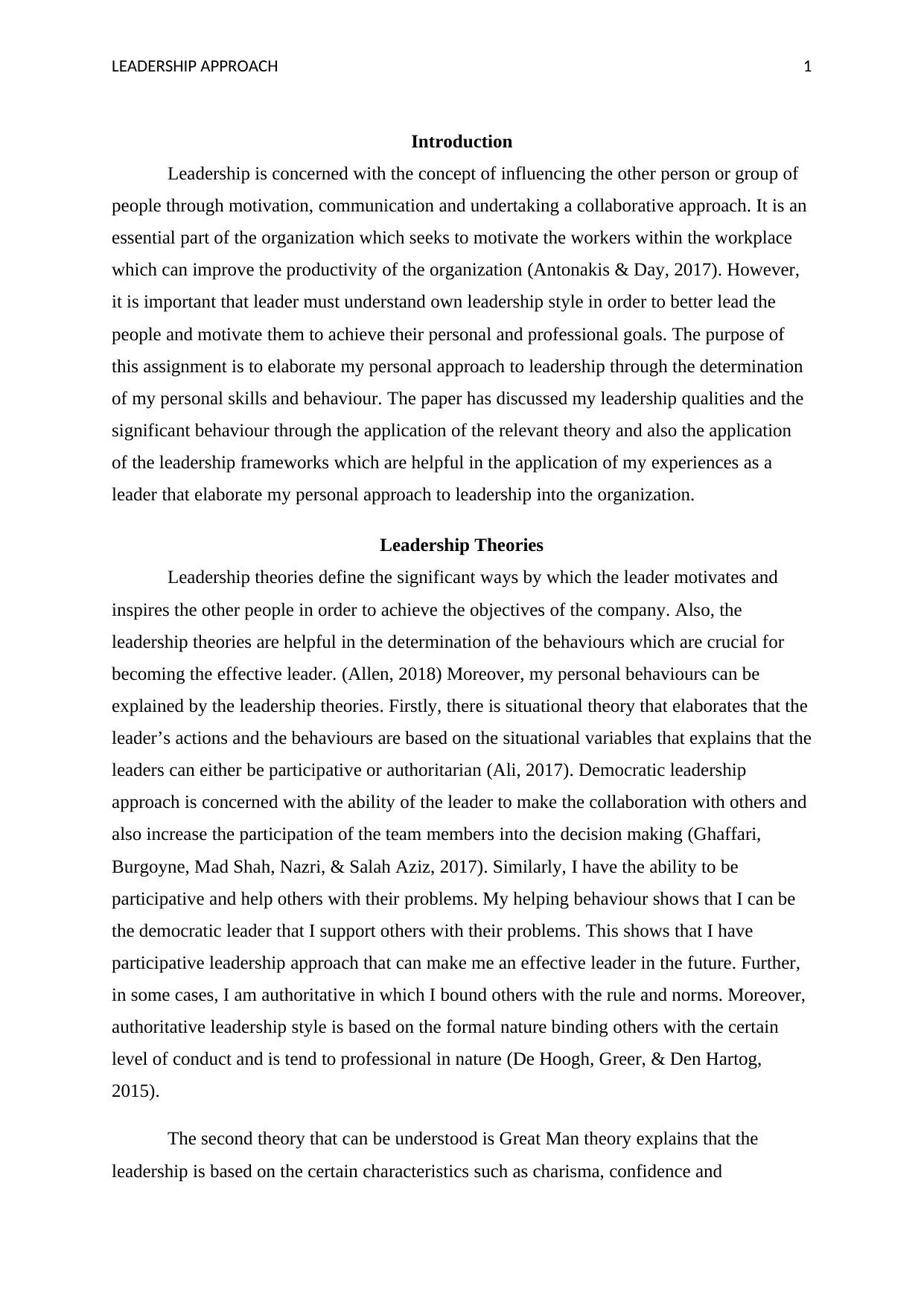
LEADERSHIP APPROACH 1
Introduction
Leadership is concerned with the concept of influencing the other person or group of
people through motivation, communication and undertaking a collaborative approach. It is an
essential part of the organization which seeks to motivate the workers within the workplace
which can improve the productivity of the organization (Antonakis & Day, 2017). However,
it is important that leader must understand own leadership style in order to better lead the
people and motivate them to achieve their personal and professional goals. The purpose of
this assignment is to elaborate my personal approach to leadership through the determination
of my personal skills and behaviour. The paper has discussed my leadership qualities and the
significant behaviour through the application of the relevant theory and also the application
of the leadership frameworks which are helpful in the application of my experiences as a
leader that elaborate my personal approach to leadership into the organization.
Leadership Theories
Leadership theories define the significant ways by which the leader motivates and
inspires the other people in order to achieve the objectives of the company. Also, the
leadership theories are helpful in the determination of the behaviours which are crucial for
becoming the effective leader. (Allen, 2018) Moreover, my personal behaviours can be
explained by the leadership theories. Firstly, there is situational theory that elaborates that the
leader’s actions and the behaviours are based on the situational variables that explains that the
leaders can either be participative or authoritarian (Ali, 2017). Democratic leadership
approach is concerned with the ability of the leader to make the collaboration with others and
also increase the participation of the team members into the decision making (Ghaffari,
Burgoyne, Mad Shah, Nazri, & Salah Aziz, 2017). Similarly, I have the ability to be
participative and help others with their problems. My helping behaviour shows that I can be
the democratic leader that I support others with their problems. This shows that I have
participative leadership approach that can make me an effective leader in the future. Further,
in some cases, I am authoritative in which I bound others with the rule and norms. Moreover,
authoritative leadership style is based on the formal nature binding others with the certain
level of conduct and is tend to professional in nature (De Hoogh, Greer, & Den Hartog,
2015).
The second theory that can be understood is Great Man theory explains that the
leadership is based on the certain characteristics such as charisma, confidence and
Introduction
Leadership is concerned with the concept of influencing the other person or group of
people through motivation, communication and undertaking a collaborative approach. It is an
essential part of the organization which seeks to motivate the workers within the workplace
which can improve the productivity of the organization (Antonakis & Day, 2017). However,
it is important that leader must understand own leadership style in order to better lead the
people and motivate them to achieve their personal and professional goals. The purpose of
this assignment is to elaborate my personal approach to leadership through the determination
of my personal skills and behaviour. The paper has discussed my leadership qualities and the
significant behaviour through the application of the relevant theory and also the application
of the leadership frameworks which are helpful in the application of my experiences as a
leader that elaborate my personal approach to leadership into the organization.
Leadership Theories
Leadership theories define the significant ways by which the leader motivates and
inspires the other people in order to achieve the objectives of the company. Also, the
leadership theories are helpful in the determination of the behaviours which are crucial for
becoming the effective leader. (Allen, 2018) Moreover, my personal behaviours can be
explained by the leadership theories. Firstly, there is situational theory that elaborates that the
leader’s actions and the behaviours are based on the situational variables that explains that the
leaders can either be participative or authoritarian (Ali, 2017). Democratic leadership
approach is concerned with the ability of the leader to make the collaboration with others and
also increase the participation of the team members into the decision making (Ghaffari,
Burgoyne, Mad Shah, Nazri, & Salah Aziz, 2017). Similarly, I have the ability to be
participative and help others with their problems. My helping behaviour shows that I can be
the democratic leader that I support others with their problems. This shows that I have
participative leadership approach that can make me an effective leader in the future. Further,
in some cases, I am authoritative in which I bound others with the rule and norms. Moreover,
authoritative leadership style is based on the formal nature binding others with the certain
level of conduct and is tend to professional in nature (De Hoogh, Greer, & Den Hartog,
2015).
The second theory that can be understood is Great Man theory explains that the
leadership is based on the certain characteristics such as charisma, confidence and
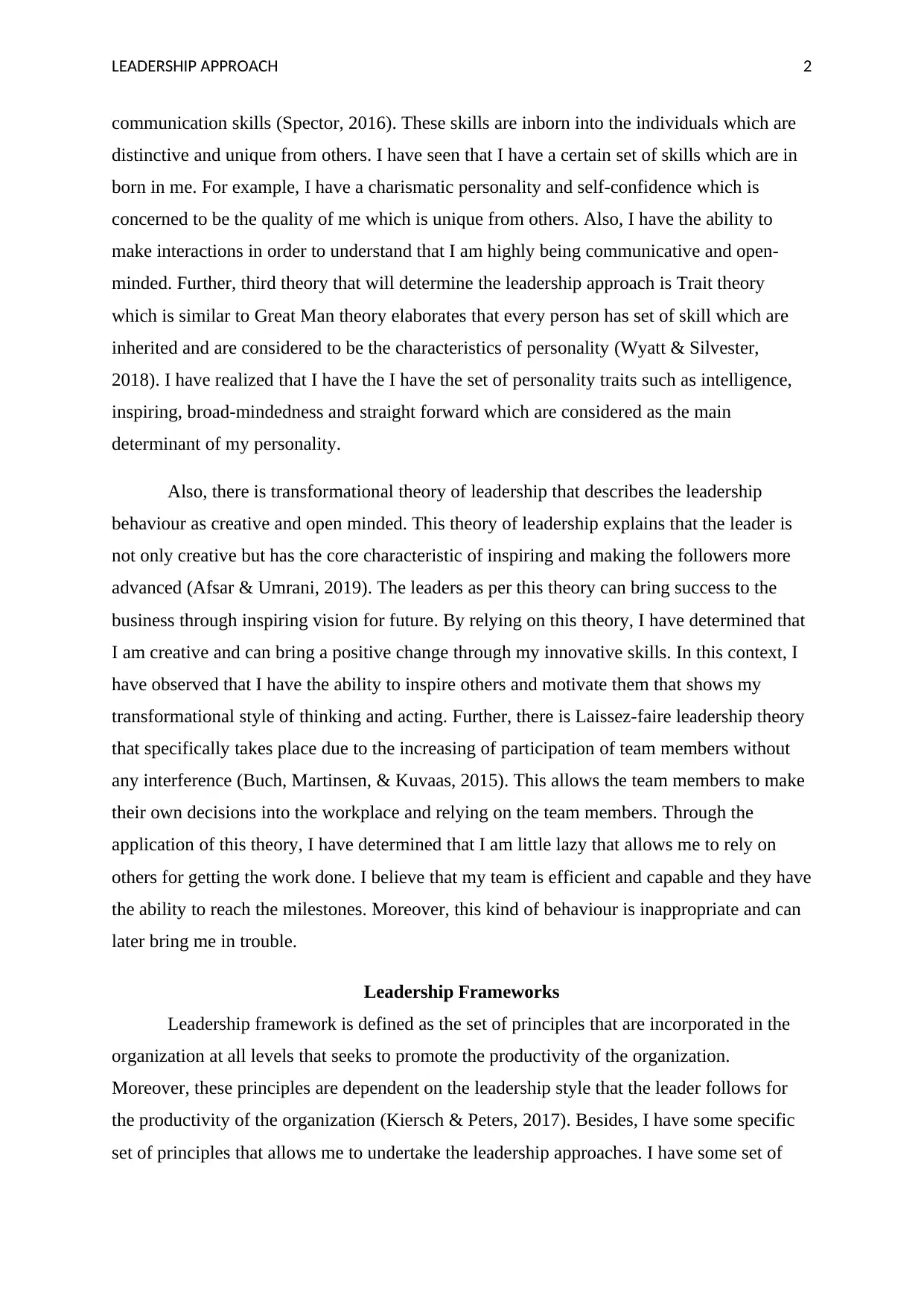
LEADERSHIP APPROACH 2
communication skills (Spector, 2016). These skills are inborn into the individuals which are
distinctive and unique from others. I have seen that I have a certain set of skills which are in
born in me. For example, I have a charismatic personality and self-confidence which is
concerned to be the quality of me which is unique from others. Also, I have the ability to
make interactions in order to understand that I am highly being communicative and open-
minded. Further, third theory that will determine the leadership approach is Trait theory
which is similar to Great Man theory elaborates that every person has set of skill which are
inherited and are considered to be the characteristics of personality (Wyatt & Silvester,
2018). I have realized that I have the I have the set of personality traits such as intelligence,
inspiring, broad-mindedness and straight forward which are considered as the main
determinant of my personality.
Also, there is transformational theory of leadership that describes the leadership
behaviour as creative and open minded. This theory of leadership explains that the leader is
not only creative but has the core characteristic of inspiring and making the followers more
advanced (Afsar & Umrani, 2019). The leaders as per this theory can bring success to the
business through inspiring vision for future. By relying on this theory, I have determined that
I am creative and can bring a positive change through my innovative skills. In this context, I
have observed that I have the ability to inspire others and motivate them that shows my
transformational style of thinking and acting. Further, there is Laissez-faire leadership theory
that specifically takes place due to the increasing of participation of team members without
any interference (Buch, Martinsen, & Kuvaas, 2015). This allows the team members to make
their own decisions into the workplace and relying on the team members. Through the
application of this theory, I have determined that I am little lazy that allows me to rely on
others for getting the work done. I believe that my team is efficient and capable and they have
the ability to reach the milestones. Moreover, this kind of behaviour is inappropriate and can
later bring me in trouble.
Leadership Frameworks
Leadership framework is defined as the set of principles that are incorporated in the
organization at all levels that seeks to promote the productivity of the organization.
Moreover, these principles are dependent on the leadership style that the leader follows for
the productivity of the organization (Kiersch & Peters, 2017). Besides, I have some specific
set of principles that allows me to undertake the leadership approaches. I have some set of
communication skills (Spector, 2016). These skills are inborn into the individuals which are
distinctive and unique from others. I have seen that I have a certain set of skills which are in
born in me. For example, I have a charismatic personality and self-confidence which is
concerned to be the quality of me which is unique from others. Also, I have the ability to
make interactions in order to understand that I am highly being communicative and open-
minded. Further, third theory that will determine the leadership approach is Trait theory
which is similar to Great Man theory elaborates that every person has set of skill which are
inherited and are considered to be the characteristics of personality (Wyatt & Silvester,
2018). I have realized that I have the I have the set of personality traits such as intelligence,
inspiring, broad-mindedness and straight forward which are considered as the main
determinant of my personality.
Also, there is transformational theory of leadership that describes the leadership
behaviour as creative and open minded. This theory of leadership explains that the leader is
not only creative but has the core characteristic of inspiring and making the followers more
advanced (Afsar & Umrani, 2019). The leaders as per this theory can bring success to the
business through inspiring vision for future. By relying on this theory, I have determined that
I am creative and can bring a positive change through my innovative skills. In this context, I
have observed that I have the ability to inspire others and motivate them that shows my
transformational style of thinking and acting. Further, there is Laissez-faire leadership theory
that specifically takes place due to the increasing of participation of team members without
any interference (Buch, Martinsen, & Kuvaas, 2015). This allows the team members to make
their own decisions into the workplace and relying on the team members. Through the
application of this theory, I have determined that I am little lazy that allows me to rely on
others for getting the work done. I believe that my team is efficient and capable and they have
the ability to reach the milestones. Moreover, this kind of behaviour is inappropriate and can
later bring me in trouble.
Leadership Frameworks
Leadership framework is defined as the set of principles that are incorporated in the
organization at all levels that seeks to promote the productivity of the organization.
Moreover, these principles are dependent on the leadership style that the leader follows for
the productivity of the organization (Kiersch & Peters, 2017). Besides, I have some specific
set of principles that allows me to undertake the leadership approaches. I have some set of
⊘ This is a preview!⊘
Do you want full access?
Subscribe today to unlock all pages.

Trusted by 1+ million students worldwide
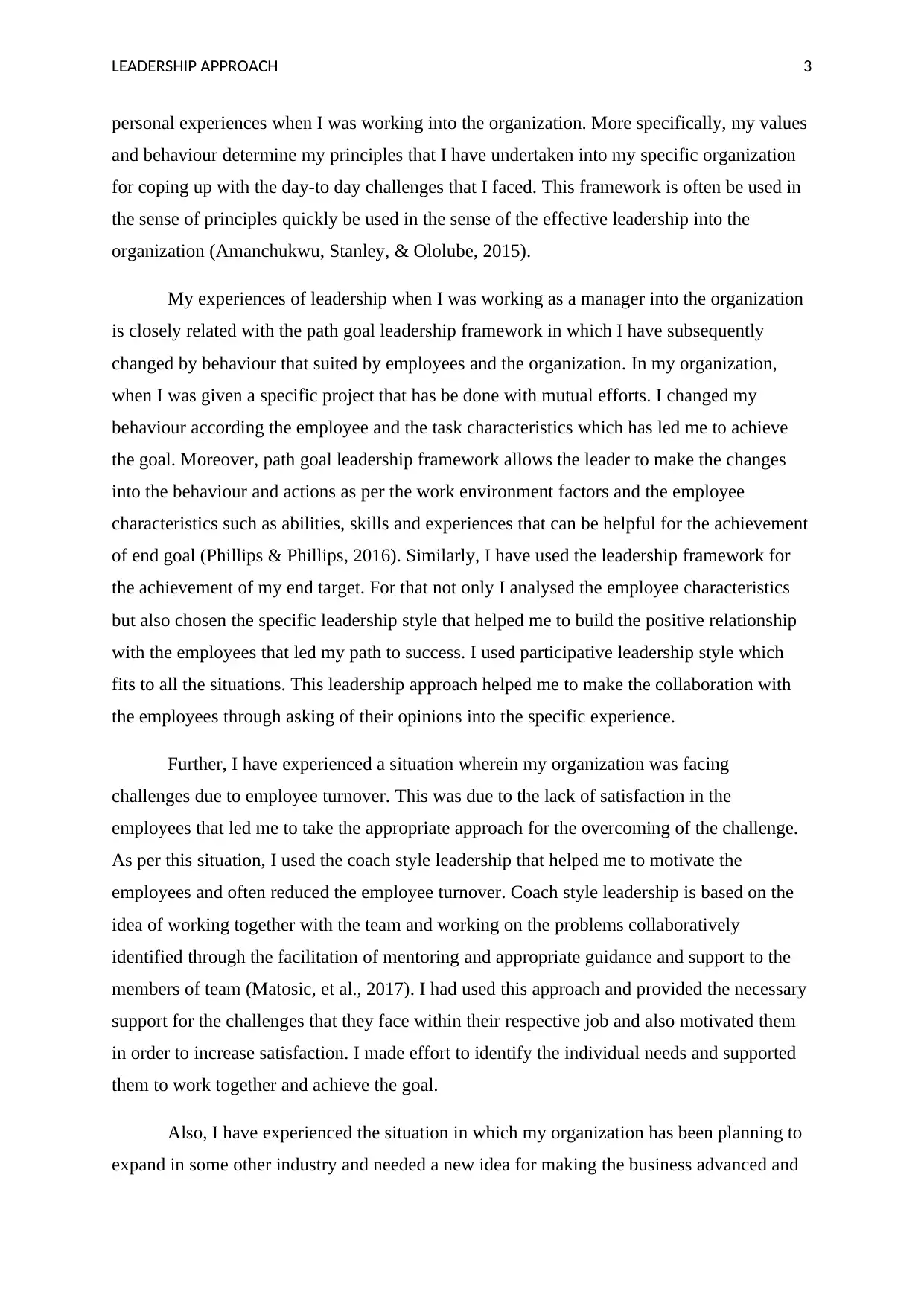
LEADERSHIP APPROACH 3
personal experiences when I was working into the organization. More specifically, my values
and behaviour determine my principles that I have undertaken into my specific organization
for coping up with the day-to day challenges that I faced. This framework is often be used in
the sense of principles quickly be used in the sense of the effective leadership into the
organization (Amanchukwu, Stanley, & Ololube, 2015).
My experiences of leadership when I was working as a manager into the organization
is closely related with the path goal leadership framework in which I have subsequently
changed by behaviour that suited by employees and the organization. In my organization,
when I was given a specific project that has be done with mutual efforts. I changed my
behaviour according the employee and the task characteristics which has led me to achieve
the goal. Moreover, path goal leadership framework allows the leader to make the changes
into the behaviour and actions as per the work environment factors and the employee
characteristics such as abilities, skills and experiences that can be helpful for the achievement
of end goal (Phillips & Phillips, 2016). Similarly, I have used the leadership framework for
the achievement of my end target. For that not only I analysed the employee characteristics
but also chosen the specific leadership style that helped me to build the positive relationship
with the employees that led my path to success. I used participative leadership style which
fits to all the situations. This leadership approach helped me to make the collaboration with
the employees through asking of their opinions into the specific experience.
Further, I have experienced a situation wherein my organization was facing
challenges due to employee turnover. This was due to the lack of satisfaction in the
employees that led me to take the appropriate approach for the overcoming of the challenge.
As per this situation, I used the coach style leadership that helped me to motivate the
employees and often reduced the employee turnover. Coach style leadership is based on the
idea of working together with the team and working on the problems collaboratively
identified through the facilitation of mentoring and appropriate guidance and support to the
members of team (Matosic, et al., 2017). I had used this approach and provided the necessary
support for the challenges that they face within their respective job and also motivated them
in order to increase satisfaction. I made effort to identify the individual needs and supported
them to work together and achieve the goal.
Also, I have experienced the situation in which my organization has been planning to
expand in some other industry and needed a new idea for making the business advanced and
personal experiences when I was working into the organization. More specifically, my values
and behaviour determine my principles that I have undertaken into my specific organization
for coping up with the day-to day challenges that I faced. This framework is often be used in
the sense of principles quickly be used in the sense of the effective leadership into the
organization (Amanchukwu, Stanley, & Ololube, 2015).
My experiences of leadership when I was working as a manager into the organization
is closely related with the path goal leadership framework in which I have subsequently
changed by behaviour that suited by employees and the organization. In my organization,
when I was given a specific project that has be done with mutual efforts. I changed my
behaviour according the employee and the task characteristics which has led me to achieve
the goal. Moreover, path goal leadership framework allows the leader to make the changes
into the behaviour and actions as per the work environment factors and the employee
characteristics such as abilities, skills and experiences that can be helpful for the achievement
of end goal (Phillips & Phillips, 2016). Similarly, I have used the leadership framework for
the achievement of my end target. For that not only I analysed the employee characteristics
but also chosen the specific leadership style that helped me to build the positive relationship
with the employees that led my path to success. I used participative leadership style which
fits to all the situations. This leadership approach helped me to make the collaboration with
the employees through asking of their opinions into the specific experience.
Further, I have experienced a situation wherein my organization was facing
challenges due to employee turnover. This was due to the lack of satisfaction in the
employees that led me to take the appropriate approach for the overcoming of the challenge.
As per this situation, I used the coach style leadership that helped me to motivate the
employees and often reduced the employee turnover. Coach style leadership is based on the
idea of working together with the team and working on the problems collaboratively
identified through the facilitation of mentoring and appropriate guidance and support to the
members of team (Matosic, et al., 2017). I had used this approach and provided the necessary
support for the challenges that they face within their respective job and also motivated them
in order to increase satisfaction. I made effort to identify the individual needs and supported
them to work together and achieve the goal.
Also, I have experienced the situation in which my organization has been planning to
expand in some other industry and needed a new idea for making the business advanced and
Paraphrase This Document
Need a fresh take? Get an instant paraphrase of this document with our AI Paraphraser
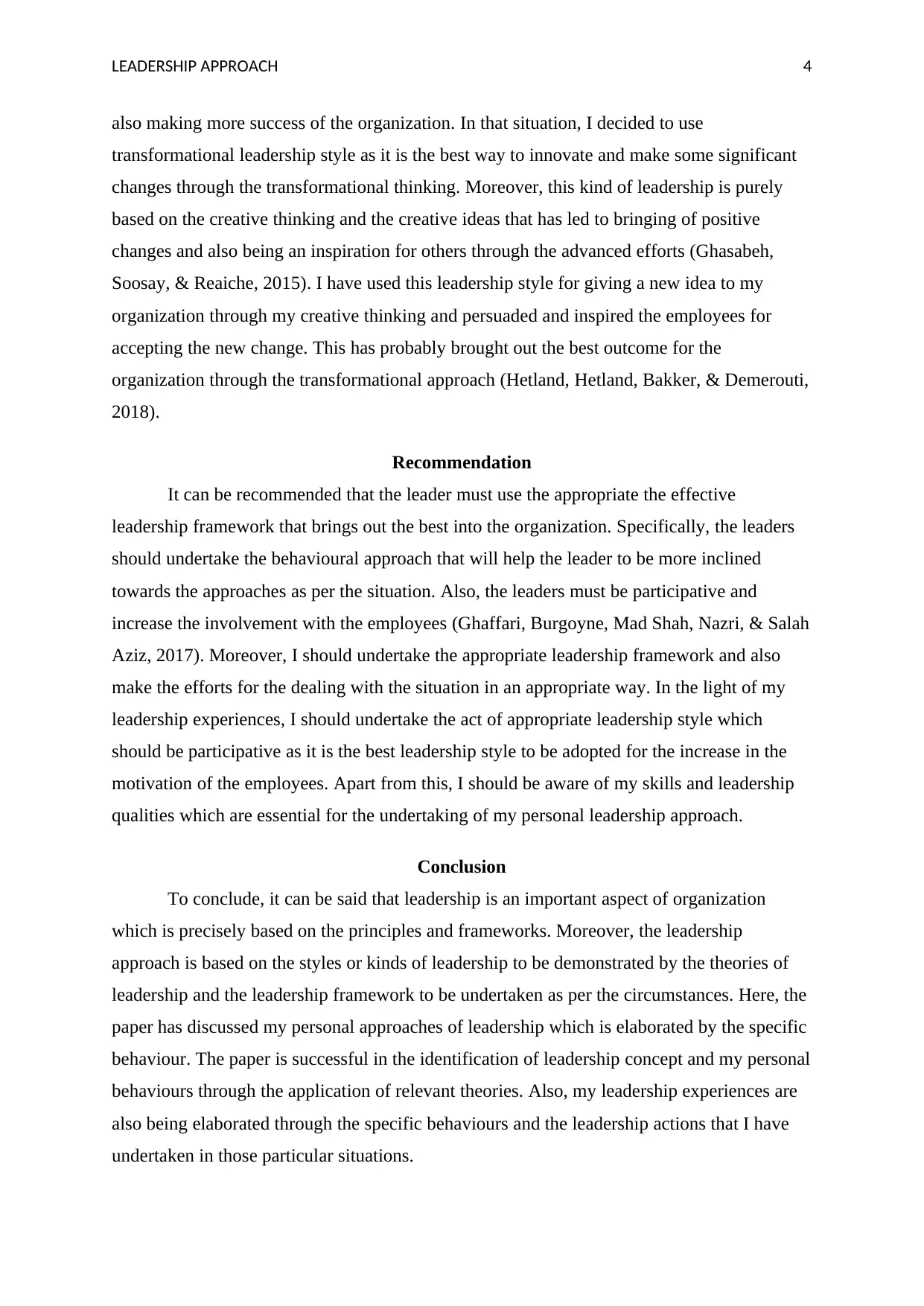
LEADERSHIP APPROACH 4
also making more success of the organization. In that situation, I decided to use
transformational leadership style as it is the best way to innovate and make some significant
changes through the transformational thinking. Moreover, this kind of leadership is purely
based on the creative thinking and the creative ideas that has led to bringing of positive
changes and also being an inspiration for others through the advanced efforts (Ghasabeh,
Soosay, & Reaiche, 2015). I have used this leadership style for giving a new idea to my
organization through my creative thinking and persuaded and inspired the employees for
accepting the new change. This has probably brought out the best outcome for the
organization through the transformational approach (Hetland, Hetland, Bakker, & Demerouti,
2018).
Recommendation
It can be recommended that the leader must use the appropriate the effective
leadership framework that brings out the best into the organization. Specifically, the leaders
should undertake the behavioural approach that will help the leader to be more inclined
towards the approaches as per the situation. Also, the leaders must be participative and
increase the involvement with the employees (Ghaffari, Burgoyne, Mad Shah, Nazri, & Salah
Aziz, 2017). Moreover, I should undertake the appropriate leadership framework and also
make the efforts for the dealing with the situation in an appropriate way. In the light of my
leadership experiences, I should undertake the act of appropriate leadership style which
should be participative as it is the best leadership style to be adopted for the increase in the
motivation of the employees. Apart from this, I should be aware of my skills and leadership
qualities which are essential for the undertaking of my personal leadership approach.
Conclusion
To conclude, it can be said that leadership is an important aspect of organization
which is precisely based on the principles and frameworks. Moreover, the leadership
approach is based on the styles or kinds of leadership to be demonstrated by the theories of
leadership and the leadership framework to be undertaken as per the circumstances. Here, the
paper has discussed my personal approaches of leadership which is elaborated by the specific
behaviour. The paper is successful in the identification of leadership concept and my personal
behaviours through the application of relevant theories. Also, my leadership experiences are
also being elaborated through the specific behaviours and the leadership actions that I have
undertaken in those particular situations.
also making more success of the organization. In that situation, I decided to use
transformational leadership style as it is the best way to innovate and make some significant
changes through the transformational thinking. Moreover, this kind of leadership is purely
based on the creative thinking and the creative ideas that has led to bringing of positive
changes and also being an inspiration for others through the advanced efforts (Ghasabeh,
Soosay, & Reaiche, 2015). I have used this leadership style for giving a new idea to my
organization through my creative thinking and persuaded and inspired the employees for
accepting the new change. This has probably brought out the best outcome for the
organization through the transformational approach (Hetland, Hetland, Bakker, & Demerouti,
2018).
Recommendation
It can be recommended that the leader must use the appropriate the effective
leadership framework that brings out the best into the organization. Specifically, the leaders
should undertake the behavioural approach that will help the leader to be more inclined
towards the approaches as per the situation. Also, the leaders must be participative and
increase the involvement with the employees (Ghaffari, Burgoyne, Mad Shah, Nazri, & Salah
Aziz, 2017). Moreover, I should undertake the appropriate leadership framework and also
make the efforts for the dealing with the situation in an appropriate way. In the light of my
leadership experiences, I should undertake the act of appropriate leadership style which
should be participative as it is the best leadership style to be adopted for the increase in the
motivation of the employees. Apart from this, I should be aware of my skills and leadership
qualities which are essential for the undertaking of my personal leadership approach.
Conclusion
To conclude, it can be said that leadership is an important aspect of organization
which is precisely based on the principles and frameworks. Moreover, the leadership
approach is based on the styles or kinds of leadership to be demonstrated by the theories of
leadership and the leadership framework to be undertaken as per the circumstances. Here, the
paper has discussed my personal approaches of leadership which is elaborated by the specific
behaviour. The paper is successful in the identification of leadership concept and my personal
behaviours through the application of relevant theories. Also, my leadership experiences are
also being elaborated through the specific behaviours and the leadership actions that I have
undertaken in those particular situations.

LEADERSHIP APPROACH 5
⊘ This is a preview!⊘
Do you want full access?
Subscribe today to unlock all pages.

Trusted by 1+ million students worldwide
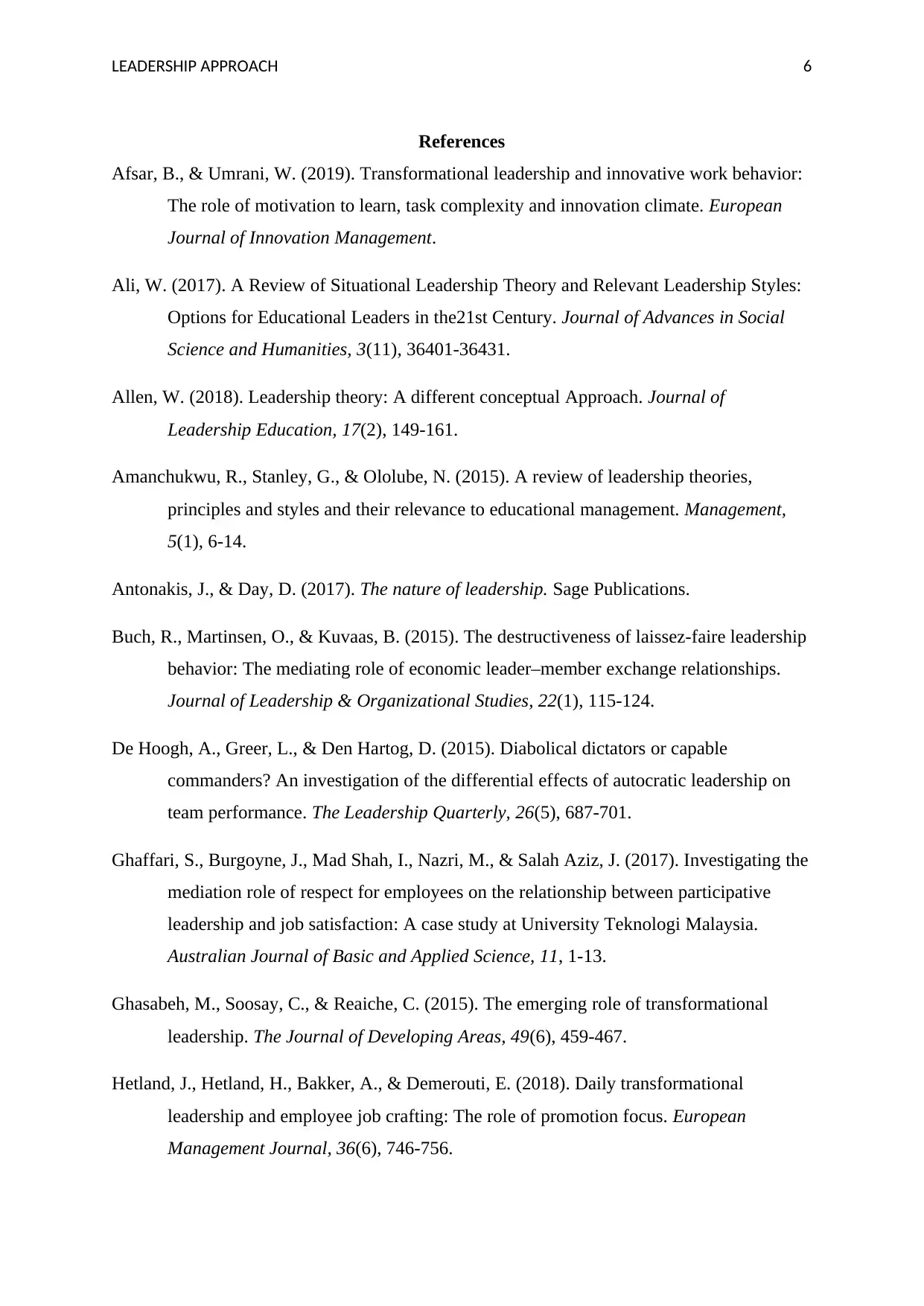
LEADERSHIP APPROACH 6
References
Afsar, B., & Umrani, W. (2019). Transformational leadership and innovative work behavior:
The role of motivation to learn, task complexity and innovation climate. European
Journal of Innovation Management.
Ali, W. (2017). A Review of Situational Leadership Theory and Relevant Leadership Styles:
Options for Educational Leaders in the21st Century. Journal of Advances in Social
Science and Humanities, 3(11), 36401-36431.
Allen, W. (2018). Leadership theory: A different conceptual Approach. Journal of
Leadership Education, 17(2), 149-161.
Amanchukwu, R., Stanley, G., & Ololube, N. (2015). A review of leadership theories,
principles and styles and their relevance to educational management. Management,
5(1), 6-14.
Antonakis, J., & Day, D. (2017). The nature of leadership. Sage Publications.
Buch, R., Martinsen, O., & Kuvaas, B. (2015). The destructiveness of laissez-faire leadership
behavior: The mediating role of economic leader–member exchange relationships.
Journal of Leadership & Organizational Studies, 22(1), 115-124.
De Hoogh, A., Greer, L., & Den Hartog, D. (2015). Diabolical dictators or capable
commanders? An investigation of the differential effects of autocratic leadership on
team performance. The Leadership Quarterly, 26(5), 687-701.
Ghaffari, S., Burgoyne, J., Mad Shah, I., Nazri, M., & Salah Aziz, J. (2017). Investigating the
mediation role of respect for employees on the relationship between participative
leadership and job satisfaction: A case study at University Teknologi Malaysia.
Australian Journal of Basic and Applied Science, 11, 1-13.
Ghasabeh, M., Soosay, C., & Reaiche, C. (2015). The emerging role of transformational
leadership. The Journal of Developing Areas, 49(6), 459-467.
Hetland, J., Hetland, H., Bakker, A., & Demerouti, E. (2018). Daily transformational
leadership and employee job crafting: The role of promotion focus. European
Management Journal, 36(6), 746-756.
References
Afsar, B., & Umrani, W. (2019). Transformational leadership and innovative work behavior:
The role of motivation to learn, task complexity and innovation climate. European
Journal of Innovation Management.
Ali, W. (2017). A Review of Situational Leadership Theory and Relevant Leadership Styles:
Options for Educational Leaders in the21st Century. Journal of Advances in Social
Science and Humanities, 3(11), 36401-36431.
Allen, W. (2018). Leadership theory: A different conceptual Approach. Journal of
Leadership Education, 17(2), 149-161.
Amanchukwu, R., Stanley, G., & Ololube, N. (2015). A review of leadership theories,
principles and styles and their relevance to educational management. Management,
5(1), 6-14.
Antonakis, J., & Day, D. (2017). The nature of leadership. Sage Publications.
Buch, R., Martinsen, O., & Kuvaas, B. (2015). The destructiveness of laissez-faire leadership
behavior: The mediating role of economic leader–member exchange relationships.
Journal of Leadership & Organizational Studies, 22(1), 115-124.
De Hoogh, A., Greer, L., & Den Hartog, D. (2015). Diabolical dictators or capable
commanders? An investigation of the differential effects of autocratic leadership on
team performance. The Leadership Quarterly, 26(5), 687-701.
Ghaffari, S., Burgoyne, J., Mad Shah, I., Nazri, M., & Salah Aziz, J. (2017). Investigating the
mediation role of respect for employees on the relationship between participative
leadership and job satisfaction: A case study at University Teknologi Malaysia.
Australian Journal of Basic and Applied Science, 11, 1-13.
Ghasabeh, M., Soosay, C., & Reaiche, C. (2015). The emerging role of transformational
leadership. The Journal of Developing Areas, 49(6), 459-467.
Hetland, J., Hetland, H., Bakker, A., & Demerouti, E. (2018). Daily transformational
leadership and employee job crafting: The role of promotion focus. European
Management Journal, 36(6), 746-756.
Paraphrase This Document
Need a fresh take? Get an instant paraphrase of this document with our AI Paraphraser
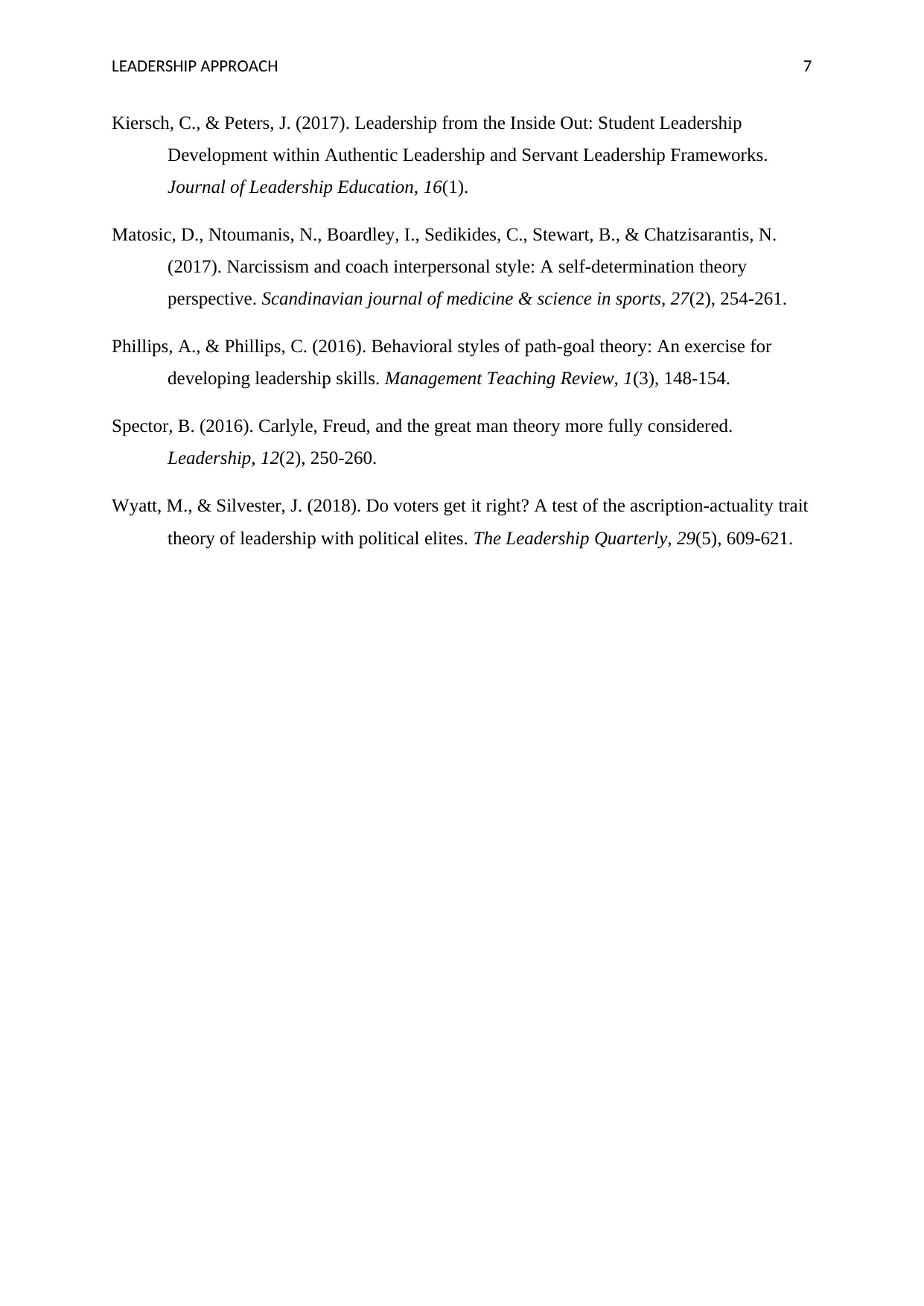
LEADERSHIP APPROACH 7
Kiersch, C., & Peters, J. (2017). Leadership from the Inside Out: Student Leadership
Development within Authentic Leadership and Servant Leadership Frameworks.
Journal of Leadership Education, 16(1).
Matosic, D., Ntoumanis, N., Boardley, I., Sedikides, C., Stewart, B., & Chatzisarantis, N.
(2017). Narcissism and coach interpersonal style: A self‐determination theory
perspective. Scandinavian journal of medicine & science in sports, 27(2), 254-261.
Phillips, A., & Phillips, C. (2016). Behavioral styles of path-goal theory: An exercise for
developing leadership skills. Management Teaching Review, 1(3), 148-154.
Spector, B. (2016). Carlyle, Freud, and the great man theory more fully considered.
Leadership, 12(2), 250-260.
Wyatt, M., & Silvester, J. (2018). Do voters get it right? A test of the ascription-actuality trait
theory of leadership with political elites. The Leadership Quarterly, 29(5), 609-621.
Kiersch, C., & Peters, J. (2017). Leadership from the Inside Out: Student Leadership
Development within Authentic Leadership and Servant Leadership Frameworks.
Journal of Leadership Education, 16(1).
Matosic, D., Ntoumanis, N., Boardley, I., Sedikides, C., Stewart, B., & Chatzisarantis, N.
(2017). Narcissism and coach interpersonal style: A self‐determination theory
perspective. Scandinavian journal of medicine & science in sports, 27(2), 254-261.
Phillips, A., & Phillips, C. (2016). Behavioral styles of path-goal theory: An exercise for
developing leadership skills. Management Teaching Review, 1(3), 148-154.
Spector, B. (2016). Carlyle, Freud, and the great man theory more fully considered.
Leadership, 12(2), 250-260.
Wyatt, M., & Silvester, J. (2018). Do voters get it right? A test of the ascription-actuality trait
theory of leadership with political elites. The Leadership Quarterly, 29(5), 609-621.
1 out of 8
Related Documents
Your All-in-One AI-Powered Toolkit for Academic Success.
+13062052269
info@desklib.com
Available 24*7 on WhatsApp / Email
![[object Object]](/_next/static/media/star-bottom.7253800d.svg)
Unlock your academic potential
Copyright © 2020–2025 A2Z Services. All Rights Reserved. Developed and managed by ZUCOL.





